When I was ready, they were waiting for me.
I mean books, of course. From the time I could read on my own, I fed myself a steady diet of whatever was in the school library, which ranged from horror (Bunnicula), murder mystery (The Dollhouse Murders), science-fiction (My Teacher is an Alien), fantasy (Into the Land of the Unicorns), horses (Ghost Horse), to fiction (Glass Slippers Give You Blisters). While I still read all those genres (less horses these days, though), I can pinpoint my specific, fervent love of fantasy to a few shelves within reach in our living room when I was young and impressionable.
The very first adult book I plucked off that shelf and read was about a cowboy who’d fallen on hard times and the school teacher who’d offered up her home and her heart—and more, although the metaphors for various human appendages went over my head. Later I would learn what a Harlequin Romance was, but at the time, while the plot was engaging, I was bored by the frequent interruptions of stuff I didn’t quite understand. So I moved on to the next shelf.
That’s where the dragons lived.
The white dragon on the cover was what grabbed me. He had a long, muscular neck, strange green eyes, and he loomed on a rocky outcropping with a saddle and a person. Dragons I knew from Dealing with Dragons (Patricia C. Wrede) and similar books, but never like this. These dragons were real in a way the others hadn’t been, with a complexity that captured me and captivated me. This was a book that said, if dragons really existed, this is how. And I believed.
That was Anne McCaffrey’s White Dragon. Maybe not the best book to start the series, but my confusion about what, exactly, was going on was easily eclipsed by OMG DRAGONS. I read the rest of the Pern books on that shelf without any regard for order or coherence. I’d found dragons and world-spanning politics and there was no turning back.
Buy the Book
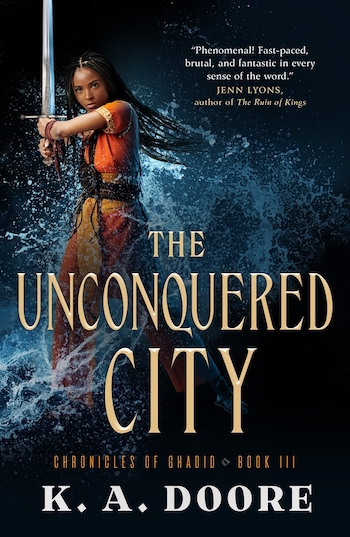

The Unconquered City
After I’d exhausted the dragon shelf, I devoured Ender’s Game and The Hobbit, along with numerous other fantasy and science-fiction books whose titles are lost to me, even as their stories and characters made an indelible dent. Either way, it was too late—fantasy had its hooks in me and the spec-fic section of the library stood no chance.
Almost 30 years later and now I have a child and a bookshelf of my own. While the child is still too young to start exploring our books, I’m already thinking about what I’ll put within easy reach. What books do I want to shape her early reading habits? Which books do I think will suck her in and—yes—guide her toward adoring fantasy as much as I?
Many have said we are living in a new golden age of fantasy and as I look around and consider what books I want on that shelf, I can’t help but agree. If anything, I don’t have the shelf space for every beautiful and thoughtful and groundbreaking and barrier-shattering and downright fantastic book I want to include.
But if I take a breath and breathe and remember that, if done right, my child will find the books she needs on her own, then it’s easier to pick a few. All I need are books that show her the best that fantasy can be: daring, adventurous, romantic, inclusive, optimistic, and limitless.
At the moment, these are the top five books or series I want to have on that shelf:
The Daevabad Trilogy by S.A. Chakraborty
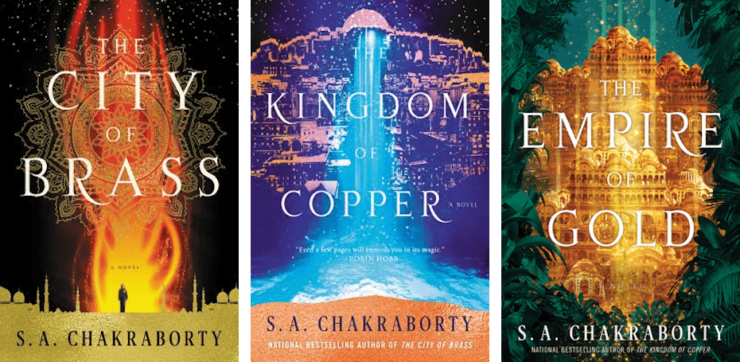
This trilogy is a one-stop series to find everything that’s wonderful in fantasy:
- an immersive and engaging story;
- complex and lovable characters who grow and change and learn;
- language that engages all the senses while still being accessible; and
- worldbuilding that feels natural and new while being grounded in mythos and history.
Chakraborty tackles real-world issues of racism and class and hate and the responsibility of power without a heavy hand, allowing the full complexity of these issues and their possible solutions to be thoroughly examined. It’s also a story that is non-stop adventure, with a thief turned reluctant princess, her murderous friend, and a prince turned reluctant revolutionary in a world of jinn, ghouls, ancient grudges, and magical cities.
AKA, the perfect gateway series for a potential lifelong genre fan.
This Is How You Lose the Time War by Amal El-Mohtar and Max Gladstone

Where the Daevabad trilogy showcases the breadth and depth that fantasy can offer, this novella is a razor-fine slice of spec fic, a rich dark chocolate mousse meant for savoring after a long day. It’s a poem of a story, told by two rivals through their letters to each other across time and space and warzones, with decadent language and sparse worldbuilding focused purely on the relationship that is its blood and bones.
This is a novella that can spark a love for language, for mounting tension and fear and despair but, in the end—for hope. It’s a modern retelling of Romeo and Juliet, with all of the inter-house antagonism, the pursuit and anguish and pining, but with an optimistic twist at the end that showcases the very beating heart of science fiction.
Also, it’s gay.
The Unspoken Name by A.K. Larkwood
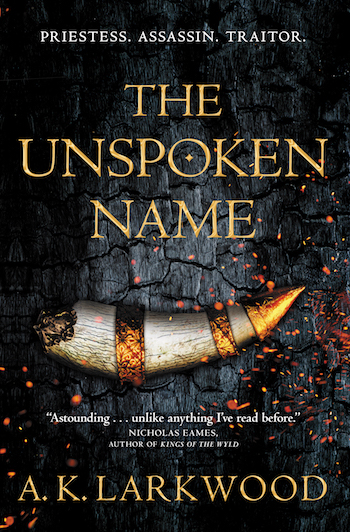
Another series that showcases the worldbuilding possibilities and imagination that fantasy does so very well, The Unspoken Name is fast and furious and breathtaking. Less political than the Daevabad trilogy, this book is more of a character examination writ large.
An orc priestess doomed to die for her god since birth is handed a possibility she never dreamed of: running away and living, despite and in spite. What follows is a story about owning your destiny and breaking free from the dogma that had fully defined your life to find that the world is so very much bigger than you could have ever dreamed.
AKA the perfect thing for someone reaching beyond the children’s section for the first time.
The soft sapphic romance at its heart definitely doesn’t hurt, either.
Boneshaker by Cherie Priest
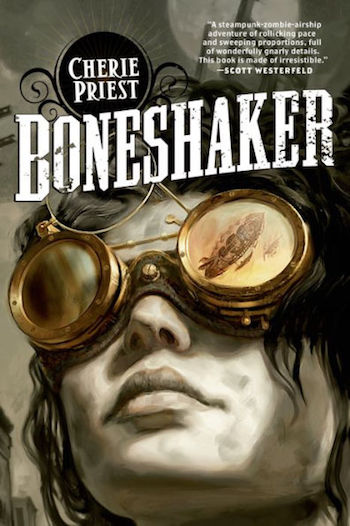
For a taste of what fantasy can do with history, this story about a mom trying to find and save her son from a 19th-century post goldrush Seattle that has been walled off due to a zombie plague is perfection. A beautiful blend of steampunk and horror that doesn’t try to whitewash the past, but instead embraces its complexities and diversity.
It’s a great way to learn about how a now-big city like Seattle started out—you know, before the whole zombie thing. Letting you explore and learn about our world through the lens of the fantastic is what fantasy does best, and Boneshaker is a great introduction.
With bonus: zombies.
The Wayward Children series by Seanan McGuire
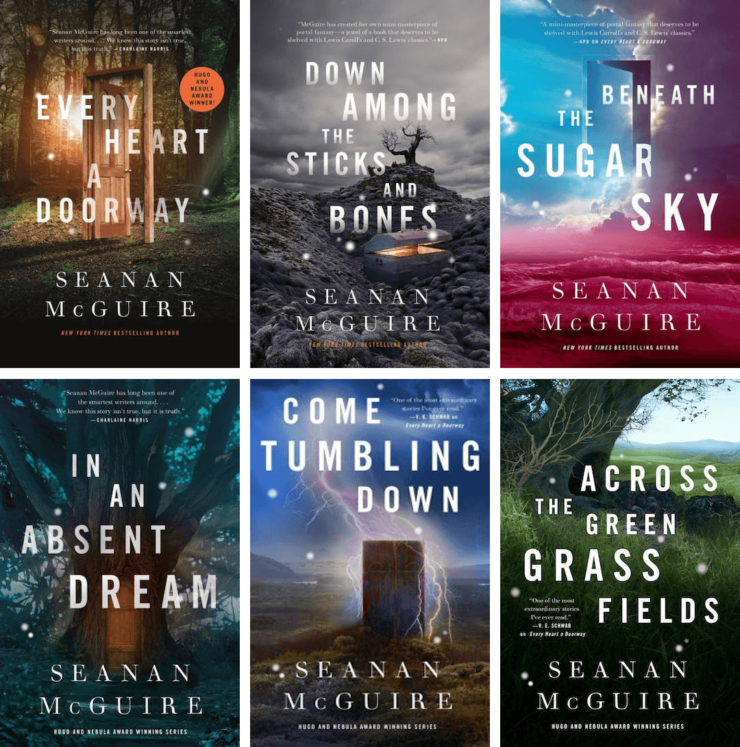
For every child forgotten or lost or unloved or simply in need of adventure, there is a door. Beyond that door, there is a world that is perfect just for them. But when that world is done with them—whether or not the child is done with the world—they are spat back into ours as if no time had passed.
The even books in the series tell us about those adventures, and the odd books tell us about what happens after. A spiritual successor to Narnia, but every bit as deep and engrossing, these novellas are short and quick and made for rereading. They are effortlessly inclusive and kind, sharing such a diversity of identities that I’m all but certain my child will find herself somewhere in those pages.
And if not? Then she can dream about a world of her own just on the other side of a door, and take her first steps into storytelling on her own.
Any one of these books or series would be a perfect gateway into discovering the joys and riches that fantasy can offer today. And if she doesn’t like any of these, there’s always the library.
What books would you have on your shelf?
K.A. Doore was born in Florida but has since lived in Washington, Arizona, and Germany. She has a BA in Classics and Foreign Languages and an enduring fascination with linguistics. These days she writes fantasy in mid-Michigan and develops online trainings for child welfare professionals. The Chronicles of Ghadid—The Perfect Assassin,The Impossible Contract, and The Unconquered City—are available from Tor Books.











People should always have horses in their books. Also, cats and dogs. It’s one of those things that makes being a human worth while.
I gave the siblings’ kids, THE HOBBIT and LORD OF THE RINGS. The stepnephews enjoyed Rick Riordan’s Percy Jackson series. The Alanna novels by Tamara Pierce. And, of course, Harry Potter.
The real trick is to find a book that suits the kid so he/she will learn the love of reading, a gift that will only improve their lives.
I would add the Young Wizards series by Diane Duane, as well as anything by Dianne Wynne Jones. The Earthsea series as well.
My first choice would be Le Guin’s Earthsea series.
Most of the books I am gathering for the kidlet in my household are the old school ones. Susan Cooper’s The Dark is Rising series, Diamond in the Window, Zelazny’s Chronicles of Amber are what I’ve gotten a hold of so far. I’m also getting some of the Rick Riordan Presents series because they’re modernized non-Western mythologies that are both fun and informative. Another series I’m slowly collecting is the “Who was/is? What is?” series that covers all sorcts of history in easy to read early middle school language.
Any books by
Beverly Cleary, Alfred Slote, Heinlen, Bujold, Margaret Weis & Tracy Hickman Dragon Lance Series, Molly Cochran Forever King Series, Ben Bova, l.e. Modesitt, Jules Verne, Dumas, Eddings, Feist, Weber,
I could go on.
Great selections! I would have to include my Top Ten favorites, which changes every few years.
This is How You Lose The Time War is great, but I think it would be pretty incomprehensible to a kid.
I’d suggest Tamora Pierce’s Circle of Magic and Protector of the Small series for starters (and the first three of the Wildmage books), as well as Naomi Novik’s Spinning Silver and, for dragons, her Temeraire series.
And, of course, The Hobbit and The Lord of the Rings.
I think a large percentage of books for younger readers are fantasy; it’s not hard to find. If you’re looking for something rich and strange, though, then you’ve got to go looking.
The Children of Green Knowe, by Lucy M Boston – the whole series is a mix of ghosts and fables.
The Box of Delights – personally, I think the Dark is Rising is kind of a rip-off of this earlier classic, which has far stronger female characters and far richer language.
Whispering in the Wind, by Alan Marshall – this is an Australian fairy-tale, with tall tales, kangaroos, and perhaps an Indigenous princess.
To all the excellent suggestions above, I would add in the Prydain Chronicles. And the Tiffany Aching books (at least).
@7,
I read Black Elk Speaks at an early age. I didn’t get everything, but some of it stayed with me, informing future reads. Kids will read what is there for them, and will always take something.
I have them in ebook, but for a hypothetical future child discovering adult fiction, I think I’d spring for hard copies of all T Kingfisher’s fantasy novels. The kid would already be acquainted with her work as Ursula Vernon, as you can be dang sure any hypothetical child of mine would have copies of Hamster Princess and Castle Hangnail in their own library, so discovering her adult work would be an easy transition. And the humour and humanity of those books shines.
I think I’d also put Charles De Lint’s short story anthologies on a low shelf. They were my first introduction to urban fantasy, to the very concept that magic could be a part of the NOW, not the long ago and far away, and twelve year old me was enthralled.
Pratchett, of course. Mm, and Robin McKinley, all her fairy tale novels (though Deerskin might go on a slightly higher shelf. Or… maybe not? Children find books when they’re ready and they’re often ready for the darkness sooner than we’d expect or like). Bujold? Would I have loved Bujold as much if I had found her sooner, tiny and voracious? O
On my children’s bookshelf are Nevermoor (Morrigan Crow) books, Moomins, Little Prince, Astrid Lindgren’s Pippi Longstocking and Ronia the Robber’s Daughter, Neverending Story, Harry Potter, Oz, Narnia, Neil Gaiman’s Coraline and Graveyard Book, Tamora Pierce’s Alanna and Emelan series, Diana Wynne Jones’ Derkholm and Year of the Griffin, Cornelia Funke and Rick Riordan’s stories.
My first fantasy series was the Chronicles of Prydain by Lloyd Alexander and it set the foundation for the rest of my life, so I consider that one essential reading for youngsters. Sword of Shannara is great when they’re ready to take the first step into a ‘really long book’.
I think you have to consider at the age of the child. Some of the books suggested here are appropriate for teens but not young children. I was raised in the 1960s as a free range kid and we could go where we wanted with no supervision. I lived at the library. There was no YA books then. So around 10 when I had read everything I could in the children’s section, my librarian suggested the The White Mountains by John Christopher. I recall clearly the joy I had when I found this kind of book existed. Aliens in a post-apocalyptic worlds written abut kids my age. I don’t know if these books are still in print. Eventually she recommended the Hobbit, LOTR and then Asimov. There where lots of other books I read as a tween but since this is limited to SFF I won’t list them here.
When I was a kid, under twelve, and wanted something new to read I’d climb up on a chair and look on the top shelf of the hall closet where we kept one of those multi-volumn collections of great authors. And that’s how I came to read H. Rider Haggard, Alexandre Dumas, and others I don’t remember as well.
Load up your shelves and turn the kids loose.
I’ll strongly second (or third or fourth) the Chronicles of Prydain, starting with the Book of Three. Huge impression when I read them in 3-4 grade and then read to my kids. The Disney Black Cauldron movie (book two) was awful – the books are sublime and very human.
By mid-teens, it’s time to go with Bujold’s Vorkosigan series.
I think a lot of Andre Norton’s works still hold up well. “Steel Magic” is a good entry-level portal fantasy, and the Solar Queen novels are noteworthy for that time for featuring an ethnically-diverse spaceship crew depicted without stereotypes. And once you get to around 1963, with the commencement of the Witch World series, there are more powerful female characters. Admittedly, the treatment of Native American characters in novels like “The Sioux Spaceman” and “The Beast Master” have not dated that well, however.
Jane Yolen , John Bellairs, Patricia McKillip, Natalie Babbit, Brian Jacques, Madeline L’Engle, Zenna Henderson, Ray Bradbury, George MacDonald, P.L. Travers (*the Mary Poppins), Hugh Lofting (*the Doctor Dolittle), E.L. Nesbitt (*the phoenix–sorry Fawkes)., Rudyard Kipling, Roald Dahl, Peter S. Beagle Mouse Guard for the right kid.
Alongside Charles DeLint, I would add War for the Oaks (more YA).
Seconding Diana Wynne Jones , Susan Cooper, Andre Norton, Robin McKinley, Lloyd Alexander, C.S. Lewis, Tolkein, Terry Pratchett
What I’ve found raising two kids a half generation apart (2nd marriage) is that the kids will find their own books, right for their period and their friends. Other parents have told me the same thing. You can curate a collection of your favorite books for them, from your childhood or your adult years, but it doesn’t mean they’ll love the same books you do.
I’ve ben able to point mine at a few classics and a few of my own faves, particularly as they grew older, but mostly they wanted to find and read the same books their friends were into. In the case of my younger child, he grew up reading Rick Riordan, Brandon Mull, Lemony Snicket, et al. And you know what? That’s great. I’ve thoroughly enjoyed reading their books and getting to see them through a younger set of eyes.
I have all of these and daughter hates SFF! Prefers horror (sobs into hands)
Booksnhorses: my children are grown, and aside from my son’s love of Elfquest and Star Wars, neither of them have the love of good SFF that I tried to instill. I’m pleased that one person here mentioned CS Lewis, and another mentioned Roger Zelazny, but no one reads Tad Williams? No one appreciates CJ Cherryh? How about Mercedes Lackey? And no one mentioned one of my all-time favorite books: Watership Down. Sad.
@21 I think Watership Down is a great suggestion — it’s an adult book that kids would find appealing, and that they would understand at whatever level they met it. Once and Future King is another such book.
Lots of good suggestions for books aimed at kids, but there’s a special childhood joy in reading books aimed at adults, and reading them through the lens of childhood. I suspect most kids would start and put down This Is How You Lose the Time War, but the ones who make it through will have a deeper appreciation of the glory that language can aspire to.
CJ Cherryh would be another good find. McKinley straddles the kid/adult divide wonderfully, as did her husband Peter Dickinson. Naomi Novak would be another good one for kids to stumble on, whether they reach for the dragons or the fairy tales. Charlaine Harris would be a good pick for vampire lovers.
My two sons both enjoyed fantasy but seemed to rarely grab from my shelves. I suspect they got lazy since I couldn’t resist constantly stocking their shelves with stuff they might like. First World Reader Problems?
@22 – Novik is a great suggestion.
I’ve having trouble seeing how Cherryh would fit the bill – maybe the Chanur books but I can’t see recommending Foreigner or Cyteen and the like.
>23 above in the comments someone wrote: “Children find books when they’re ready and they’re often ready for the darkness sooner than we’d expect or like”
I believe in giving children/youth options with more adult books, sans those with graphic violence or sex. I was reading adult books as a 9 year old, though I didn’t understand everything. I was just attracted to the stories.
@24 I don’t mind sex, although I would steer away from stuff that is unclear on consent. My experience is that kids don’t process what they aren’t ready for. For example, I (and the K.A. Doore) had The White Dragon as my introduction to Pern, but it wasn’t until a reread decades later that I even noticed that people were having sex. (And consent was a problem, so I probably wouldn’t leave that one lying around.)
@23 I think my first Cherryh was Cuckoo’s Egg and I loved the idea of the human as alien. Luckily it took me a year or two to find the Chanur books.
But again, the idea is to stock the shelves and then NOT recommend them. Part of the fun is the self-discovery.